Effect of Bulking Agents on Dewatered Sludge Biodrying Followed by Thermal Drying
Abstract
:1. Introduction
2. Materials and Methods
2.1. Materials
2.2. Experimental Equipment and Operation
2.3. Sample Analysis
2.3.1. General Indicator Analysis
2.3.2. Organic Composition Analysis
2.3.3. EPS Extraction and Three-Dimensional Excitation Emission Matrix (3D-EEM) Analysis
2.3.4. Thermal Drying Characteristics Analysis
3. Results and Discussion
3.1. Biodrying Performance
3.2. Biodegradation Patterns of Organic Matter
3.3. EPS Release and Transformation
3.4. Elemental Compositions and Calorific Values
3.5. Thermal Drying Characteristics
4. Conclusions
Author Contributions
Funding
Data Availability Statement
Acknowledgments
Conflicts of Interest
Abbreviations
| BA | bagasse | LHV | low heating value |
| CC | corncob | MC | moisture content |
| CK | control check | RDF | refuse-derived fuel |
| DOM | dissolved organic matter | SCG | spent coffee ground |
| DS | dewatered sludge | SD | sawdust |
| EPS | extracellular polymeric substance | 3D-EEM | three-dimensional excitation emission matrix |
| S-EPS | soluble EPS | VS | volatile solid |
| LB-EPS | loosely bound EPS | WDR | water desorption rate |
| TB-EPS | tightly bound EPS | WH | wheat husk |
| HHV | high heating value |
References
- Yang, B.; Hao, Z.; Jahng, D. Advances in biodrying technologies for converting organic wastes into solid fuel. Dry. Technol. 2017, 35, 1950–1969. [Google Scholar] [CrossRef]
- Ma, J.; Zhang, L.; Mu, L.; Zhu, K.; Li, A. Thermally assisted bio-drying of food waste: Synergistic enhancement and energetic evaluation. Waste Manag. 2018, 80, 327–338. [Google Scholar] [CrossRef] [PubMed]
- Ma, J.; Zhang, L.; Mu, L.; Zhu, K.; Li, A. Multivariate insights of bulking agents influence on co-biodrying of sewage sludge and food waste: Process performance, organics degradation and microbial community. Sci. Total Environ. 2019, 681, 18–27. [Google Scholar] [CrossRef] [PubMed]
- Li, Q.; Lu, X.; Guo, H.; Yang, Z.; Li, Y.; Zhi, S.; Zhang, K. Sewage sludge drying method combining pressurized electro-osmotic dewatering with subsequent bio-drying. Bioresour. Technol. 2018, 263, 94–102. [Google Scholar] [CrossRef] [PubMed]
- Yang, B.; Zhang, L.; Jahng, D. Importance of initial moisture content and bulking agent for biodrying sewage sludge. Dry. Technol. 2014, 32, 135–144. [Google Scholar] [CrossRef]
- Zhao, L.; Gu, W.; He, P.; Shao, L. Effect of air-flow rate and turning frequency on bio-drying of dewatered sludge. Water Res. 2010, 44, 6144–6152. [Google Scholar] [CrossRef]
- Hao, Z.; Yang, B.; Jahng, D. Spent coffee ground as a new bulking agent for accelerated biodrying of dewatered sludge. Water Res. 2018, 138, 250–263. [Google Scholar] [CrossRef] [PubMed]
- Hao, Z.; Jahng, D. Variations of organic matters and extracellular enzyme activities during biodrying of dewatered sludge with different bulking agents. Biochem. Eng. J. 2019, 147, 126–135. [Google Scholar] [CrossRef]
- Zhao, L.; Gu, W.; He, P.; Shao, L. Biodegradation potential of bulking agents used in sludge bio-drying and their contribution to bio-generated heat. Water Res. 2011, 45, 2322–2330. [Google Scholar] [CrossRef]
- Cai, L.; Krafft, T.; Chen, T.-B.; Gao, D.; Wang, L. Structure modification and extracellular polymeric substances conversion during sewage sludge biodrying process. Bioresour. Technol. 2016, 216, 414–421. [Google Scholar] [CrossRef]
- Zhang, Z.; Guo, L.; Wang, Y.; Li, F.; Zhao, Y.; Gao, M.; She, Z. Degradation and transformation of extracellular polymeric substances (EPS) and dissolved organic matters (DOM) during two-stage anaerobic digestion with waste sludge. Int. J. Hydrogen Energy 2017, 42, 9619–9629. [Google Scholar] [CrossRef]
- Hao, Z.; Yang, B.; Jahng, D. Combustion characteristics of biodried sewage sludge. Waste Manag. 2017, 72, 296–305. [Google Scholar] [CrossRef]
- Ma, J.; Zhang, L.; Li, A. Energy-efficient co-biodrying of dewatered sludge and food waste: Synergistic enhancement and variables investigation. Waste Manag. 2016, 56, 411–422. [Google Scholar] [CrossRef]
- Adani, F.; Baido, D.; Calcaterra, E.; Genevini, P. The influence of biomass temperature on biostabilization-biodrying of municipal solid waste. Bioresour. Technol. 2002, 83, 173–179. [Google Scholar] [CrossRef]
- Ma, J.; Zhang, L.; Mu, L.; Zhu, K.; Li, A. Energetic enhancement of thermal assistance in the cooling stage of biodrying by stimulating microbial degradation. Waste Manag. 2019, 89, 165–176. [Google Scholar] [CrossRef]
- Wang, K.; Wang, Y.-Y.; Chen, T.-B.; Zheng, G.-D.; Cao, M.-K.; Cai, L. Adding a recyclable amendment to facilitate sewage sludge biodrying and reduce costs. Chemosphere 2020, 256, 127009. [Google Scholar] [CrossRef]
- Li, J.; Plougonven, E.; Fraikin, L.; Salmon, T.; Toye, D.; Nistajakis, E.; Léonard, A. Positive operations on wastewater sludge drying: Comparison of back-mixing and sawdust addition. Energy Fuels 2016, 30, 3014–3019. [Google Scholar] [CrossRef]
- Li, J.; Fraikin, L.; Salmon, T.; Bennamoun, L.; Toye, D.; Schreinemachers, R.; Léonard, A. Investigation on Convective Drying of Mixtures of Sewage Sludge and Sawdust in a Fixed Bed. Dry. Technol. 2015, 33, 704–712. [Google Scholar] [CrossRef]
- Yang, B.; Yang, J.; Yang, H.; Liu, Y.; Li, X.; Wang, Q.; Pan, X. Co-bioevaporation treatment of concentrated landfill leachate with addition of food waste. Biochem. Eng. J. 2018, 130, 76–82. [Google Scholar] [CrossRef]
- Yang, B.; Zhang, L.; Lee, Y.; Jahng, D. Novel bioevaporation process for the zero-discharge treatment of highly concentrated organic wastewater. Water Res. 2013, 47, 5678–5689. [Google Scholar] [CrossRef]
- Chen, M.; Oshita, K.; Mahzoun, Y.; Takaoka, M.; Fukutani, S.; Shiota, K. Survey of elemental composition in dewatered sludge in Japan. Sci. Total Environ. 2021, 752, 141857. [Google Scholar] [CrossRef] [PubMed]
- He, P. Solid Waste Treatment and Energy Recovery; China Higher Education Press: Beijing, China, 2011. [Google Scholar]
- Bligh, E.G.; Dyer, W.J. A rapid method of total lipid extraction and purification. Can. J. Biochem. Physiol. 1959, 37, 911–917. [Google Scholar] [CrossRef] [PubMed]
- NY/T 3494-2019; Agricultural Biomass Raw Materials-Determination of Cellulose, Hemicellulose, and Lignin (In Chinese). Ministry of Agriculture and Rural Affairs of the PRC: Beijing, China, 2019.
- Goering, H.K.; van Soest, P.J. Forgae Fiber Analysis (Apparatus, Reagents, Procedures, and Some Applications). In USDA Agricultural Handbook No. 379; United States Department of Agriculture: Washington, DC, USA, 1970. [Google Scholar]
- Ni, B.-J.; Yan, X.; Sun, J.; Chen, X.; Peng, L.; Wei, W.; Wang, D.; Mao, S.; Dai, X.; Wang, Q. Persulfate and zero valent iron combined conditioning as a sustainable technique for enhancing dewaterability of aerobically digested sludge. Chemosphere 2019, 232, 45–53. [Google Scholar] [CrossRef] [PubMed]
- Liu, T.; Cui, C.; He, J.; Tang, J. Insights into the succession of the bacterial microbiota during biodrying of storage sludge mixed with beer lees: Studies on its biodiversity, structure, associations, and functionality. Sci. Total Environ. 2018, 644, 1088–1100. [Google Scholar] [CrossRef] [PubMed]
- Zhu, L.; Qi, H.; Lv, M.; Kong, Y.; Yu, Y.; Xu, X. Component analysis of extracellular polymeric substances (EPS) during aerobic sludge granulation using FTIR and 3D-EEM technologies. Bioresour. Technol. 2012, 124, 455–459. [Google Scholar] [CrossRef] [PubMed]
- Cai, L.; Chen, T.B.; Gao, D.; Yu, J. Bacterial communities and their association with the bio-drying of sewage sludge. Water Res. 2016, 90, 44–51. [Google Scholar] [CrossRef]
- Huiliñir, C.; Villegas, M. Simultaneous effect of initial moisture content and airflow rate on biodrying of sewage sludge. Water Res. 2015, 82, 118–128. [Google Scholar] [CrossRef]
- Chen, X.-E.; Mangindaan, D.; Chien, H.-W. Green sustainable photothermal materials by spent coffee grounds. J. Taiwan Inst. Chem. E 2022, 137, 104259. [Google Scholar] [CrossRef]
- Mangindaan, D.; Lin, G.-Y.; Kuo, C.-J.; Chien, H.-W. Biosynthesis of silver nanoparticles as catalyst by spent coffee ground/recycled poly(ethylene terephthalate) composites. Food Bioprod. Process. 2020, 121, 193–201. [Google Scholar] [CrossRef]
- Chien, H.-W.; Chen, X.-E. Spent coffee grounds as potential green photothermal materials for biofilm elimination. J. Environ. Chem. Eng. 2022, 10, 107131. [Google Scholar] [CrossRef]
- Tian, Y.; Wang, J.; Zheng, S.; He, X.; Liu, X. Research on the preparation and application of synthetic leather from coffee grounds for sustainable development. Sustainability 2022, 14, 13971. [Google Scholar] [CrossRef]
- Yuan, J.; Li, Y.; Wang, G.; Zhang, D.; Shen, Y.; Ma, R.; Li, D.; Li, S.; Li, G. Biodrying performance and combustion characteristics related to bulking agent amendments during kitchen waste biodrying. Bioresour. Technol. 2019, 284, 56–64. [Google Scholar] [CrossRef]
- Bernal, M.P.; Alburquerque, J.A.; Moral, R. Composting of animal manures and chemical criteria for compost maturity assessment. A review. Bioresour. Technol. 2009, 100, 5444–5453. [Google Scholar] [CrossRef] [PubMed]
- Liu, Y.; Hu, D.; Lin, Z.; Zhou, X.; Peng, Z.; Yang, B.; Pan, X. Degradation of biochemical fractions in different temperature of food waste bioevaporation and their contribution to biogenerated heat. J. Clean. Prod. 2020, 245, 118944. [Google Scholar] [CrossRef]
- Guo, L.; Lu, M.; Li, Q.; Zhang, J.; Zong, Y.; She, Z. Three-dimensional fluorescence excitation–emission matrix (EEM) spectroscopy with regional integration analysis for assessing waste sludge hydrolysis treated with multi-enzyme and thermophilic bacteria. Bioresour. Technol. 2014, 171, 22–28. [Google Scholar] [CrossRef]
- Gao, X.; Zhou, K.; Zhang, L.; Yang, K.; Lin, D. Distinct effects of soluble and bound exopolymeric substances on algal bioaccumulation and toxicity of anatase and rutile TiO2 nanoparticles. Environ. Sci. Nano 2018, 5, 720–729. [Google Scholar] [CrossRef]
- Wu, X.; Li, X.; Yang, Q.; Xu, Q.; Tao, Z.; Huang, X.; Wu, Y.; Tao, L.; Pi, Z.; Chen, Z.; et al. Effect of citric acid on extracellular polymeric substances disruption and cell lysis in the waste activated sludge by pH regulation. Bioresour. Technol. 2020, 302, 122859. [Google Scholar] [CrossRef] [PubMed]
- Dai, Q.; Ma, L.; Ren, N.; Ning, P.; Guo, Z.; Xie, L.; Gao, H. Investigation on extracellular polymeric substances, sludge flocs morphology, bound water release and dewatering performance of sewage sludge under pretreatment with modified phosphogypsum. Water Res. 2018, 142, 337–346. [Google Scholar] [CrossRef]
- Komilis, D.; Evangelou, A.; Giannakis, G.; Lymperis, C. Revisiting the elemental composition and the calorific value of the organic fraction of municipal solid wastes. Waste Manag. 2012, 32, 372–381. [Google Scholar] [CrossRef]
- Zhang, X.Y.; Chen, M.Q.; Huang, Y.W.; Xue, F. Isothermal hot air drying behavior of municipal sewage sludge briquettes coupled with lignite additive. Fuel 2016, 171, 108–115. [Google Scholar] [CrossRef]
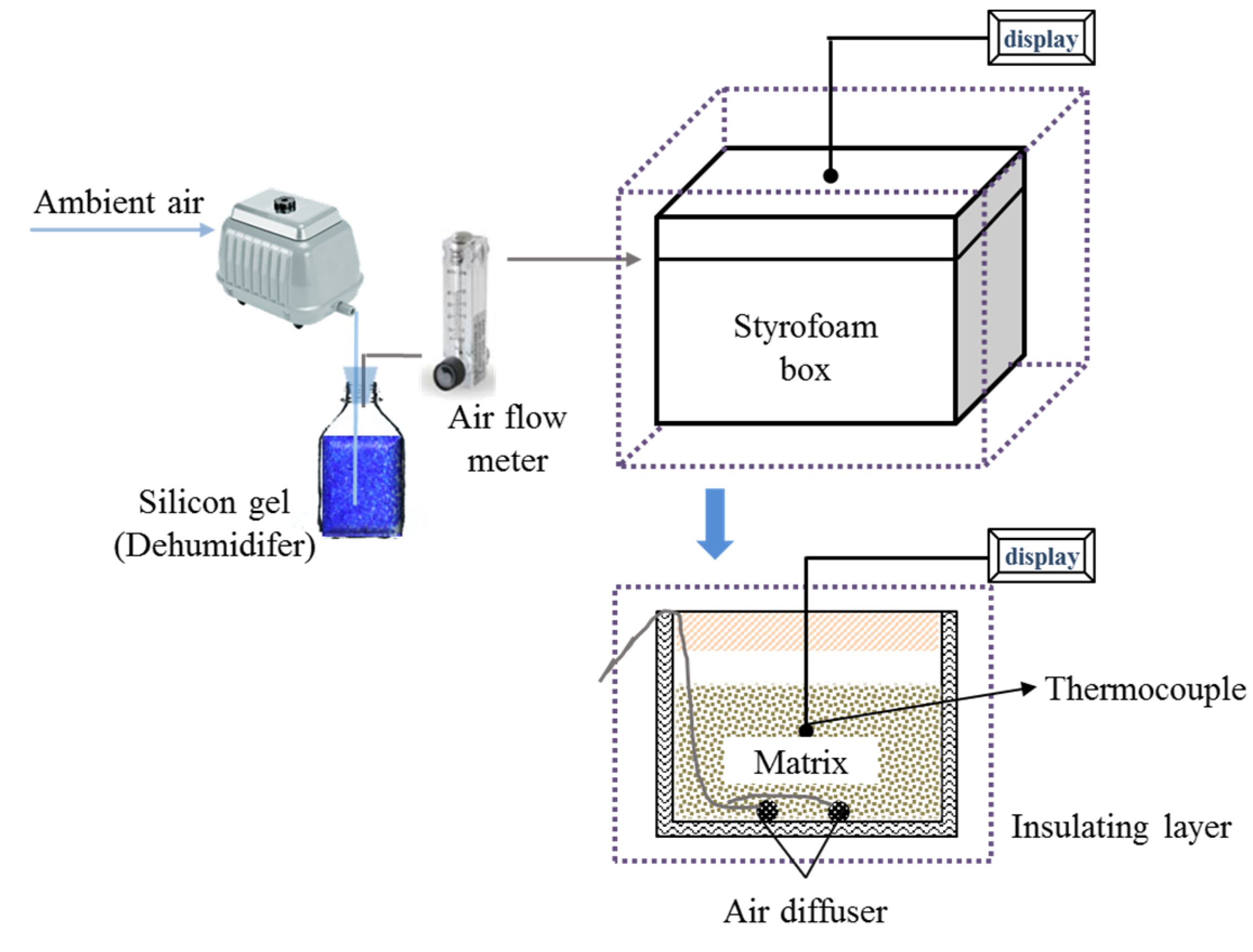
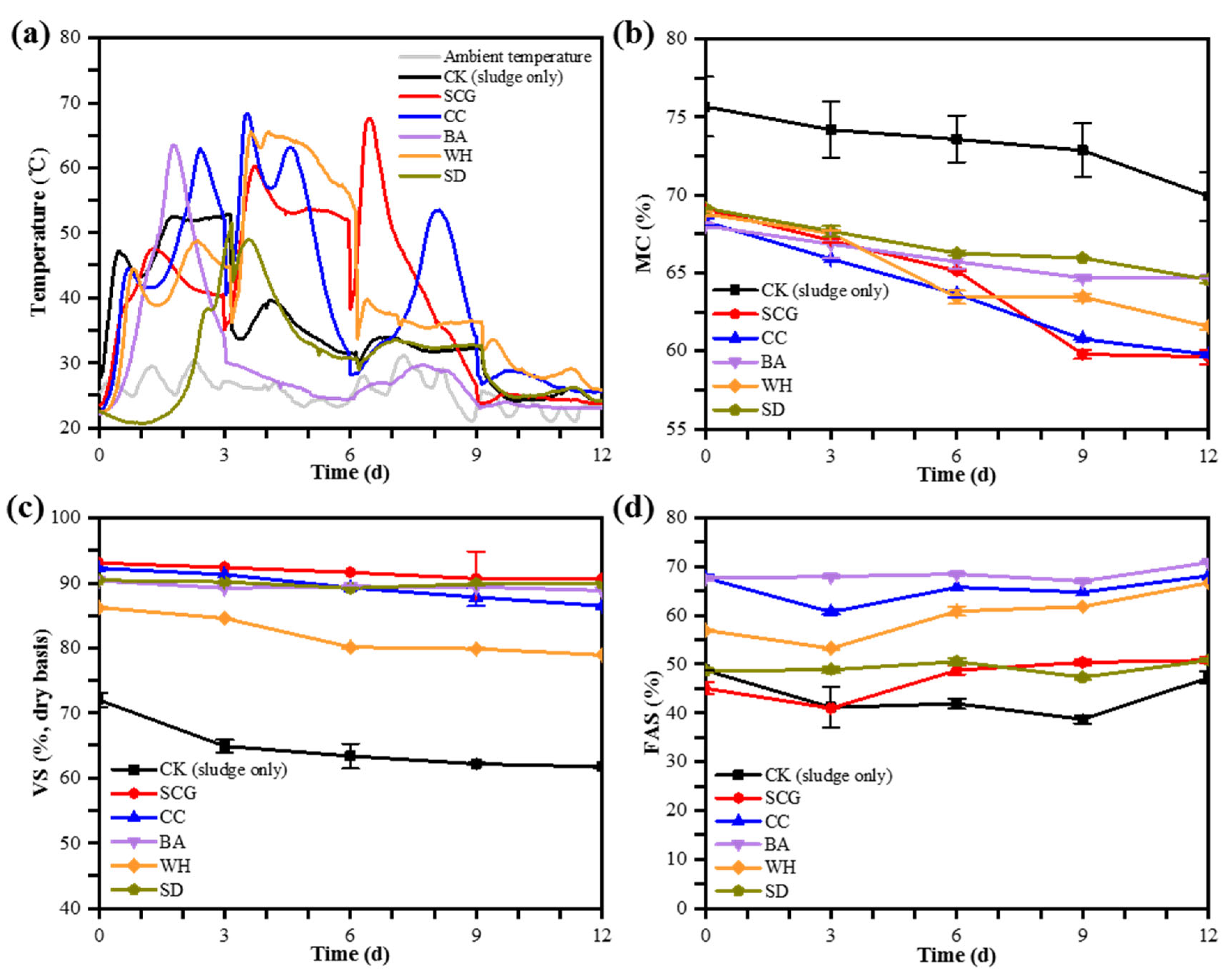
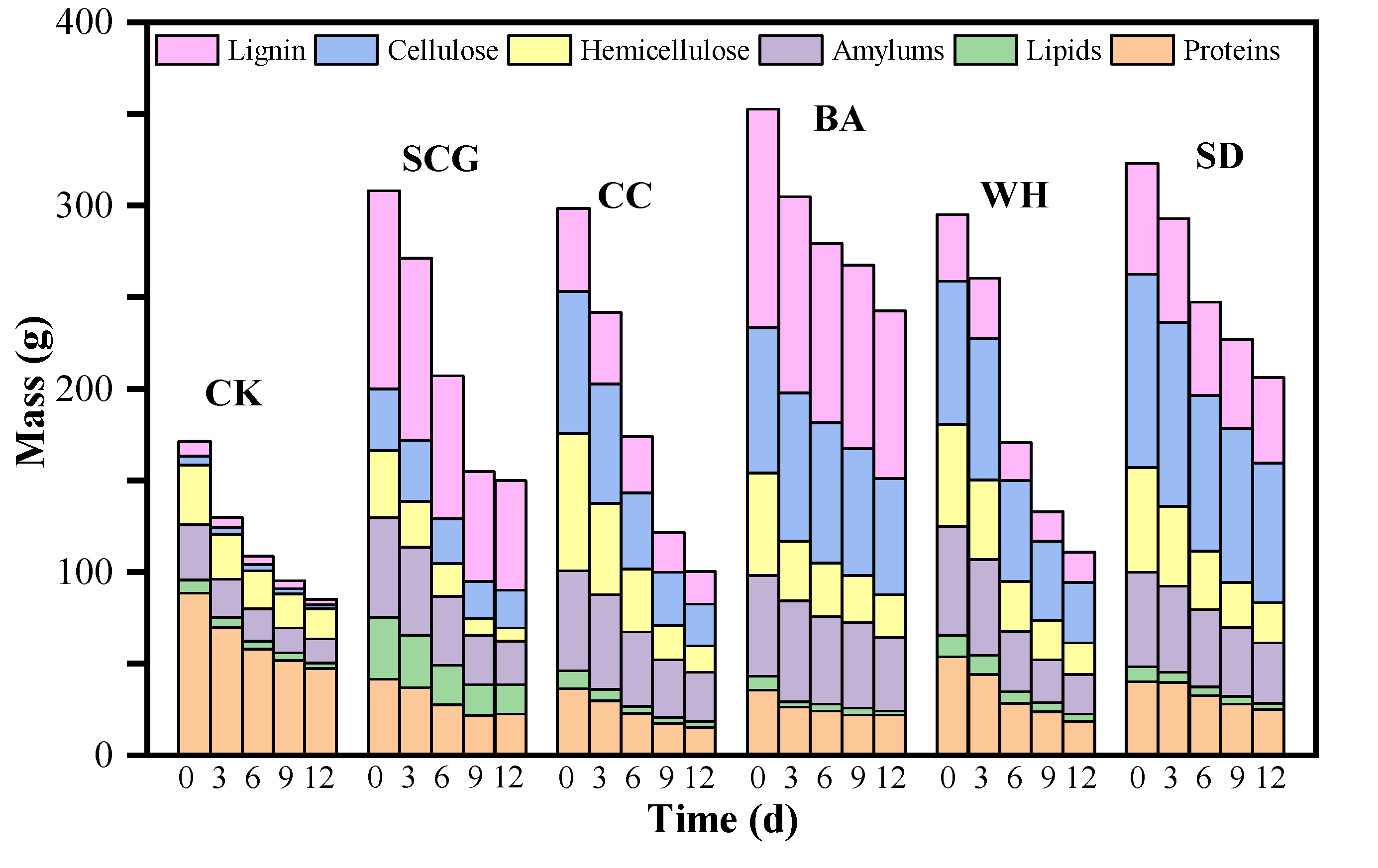

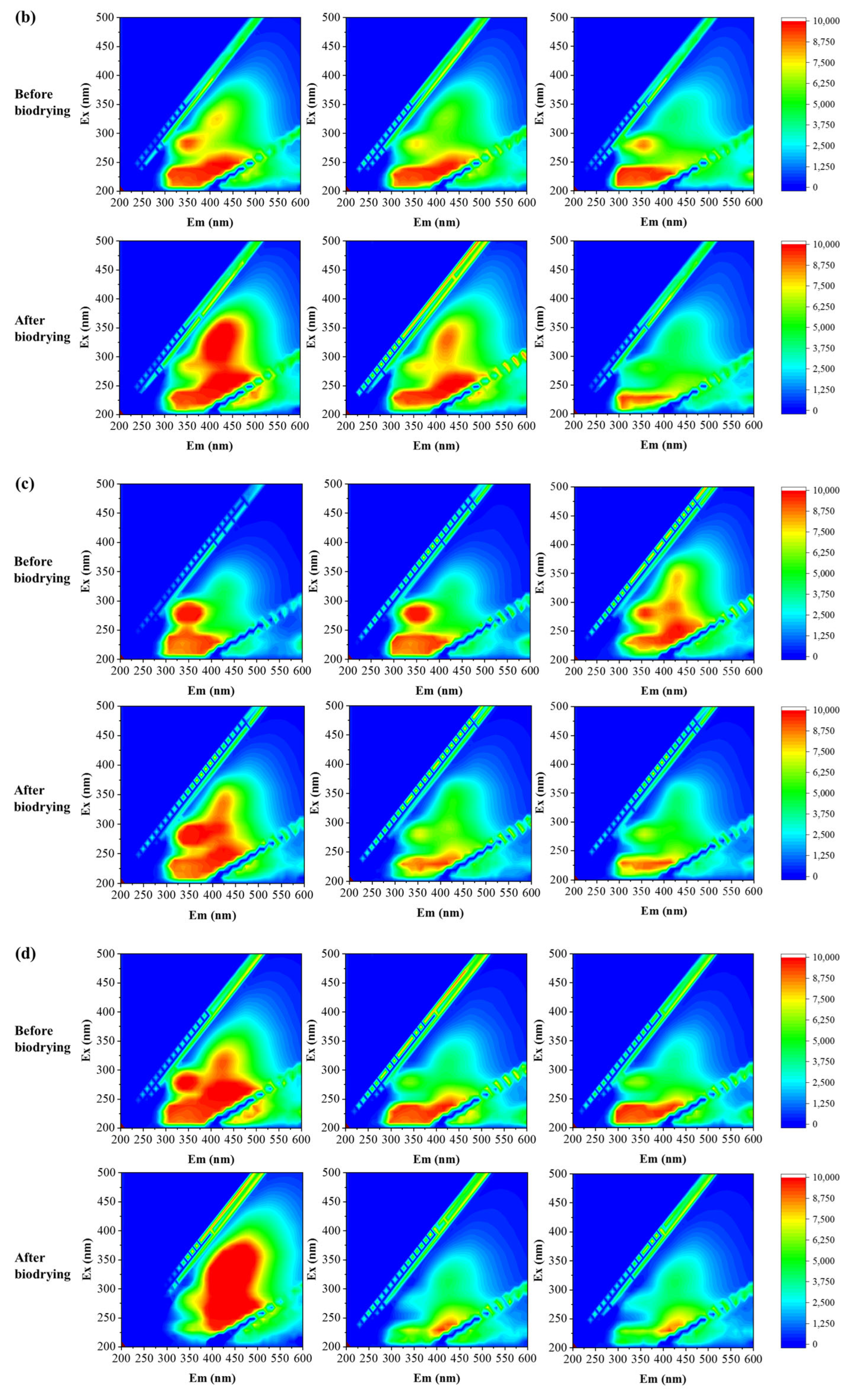

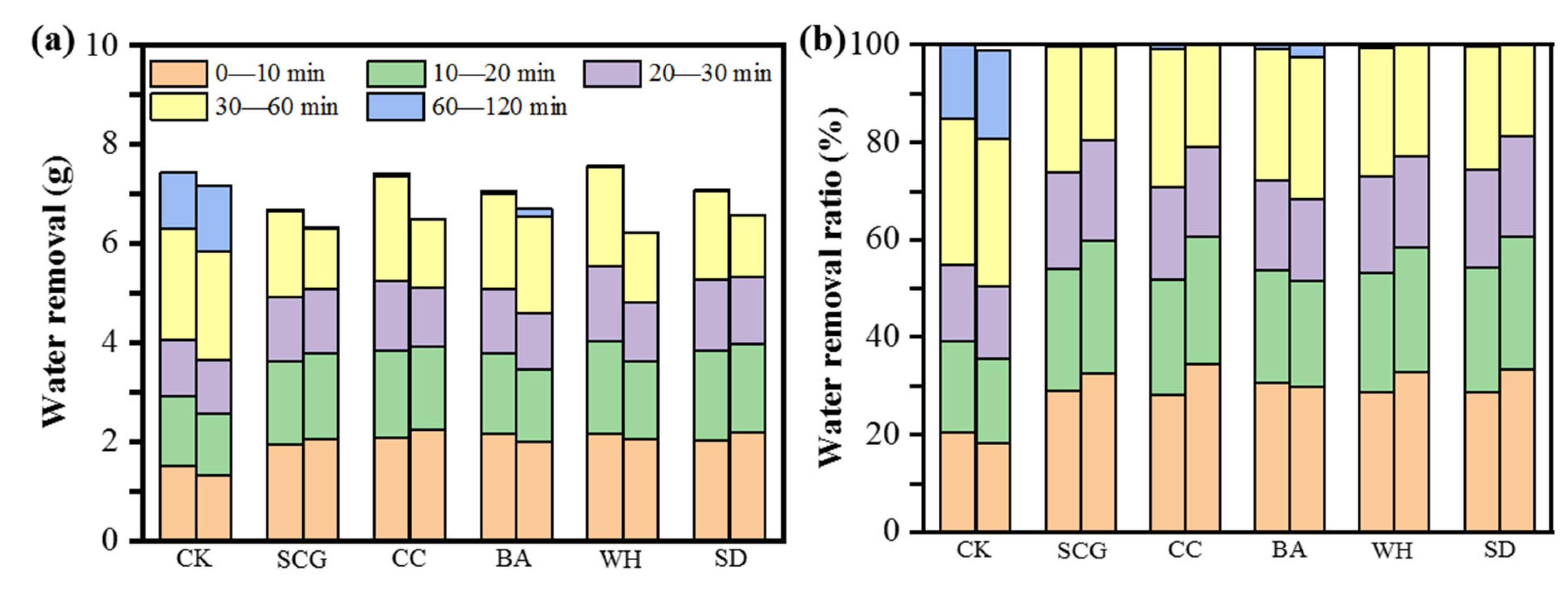
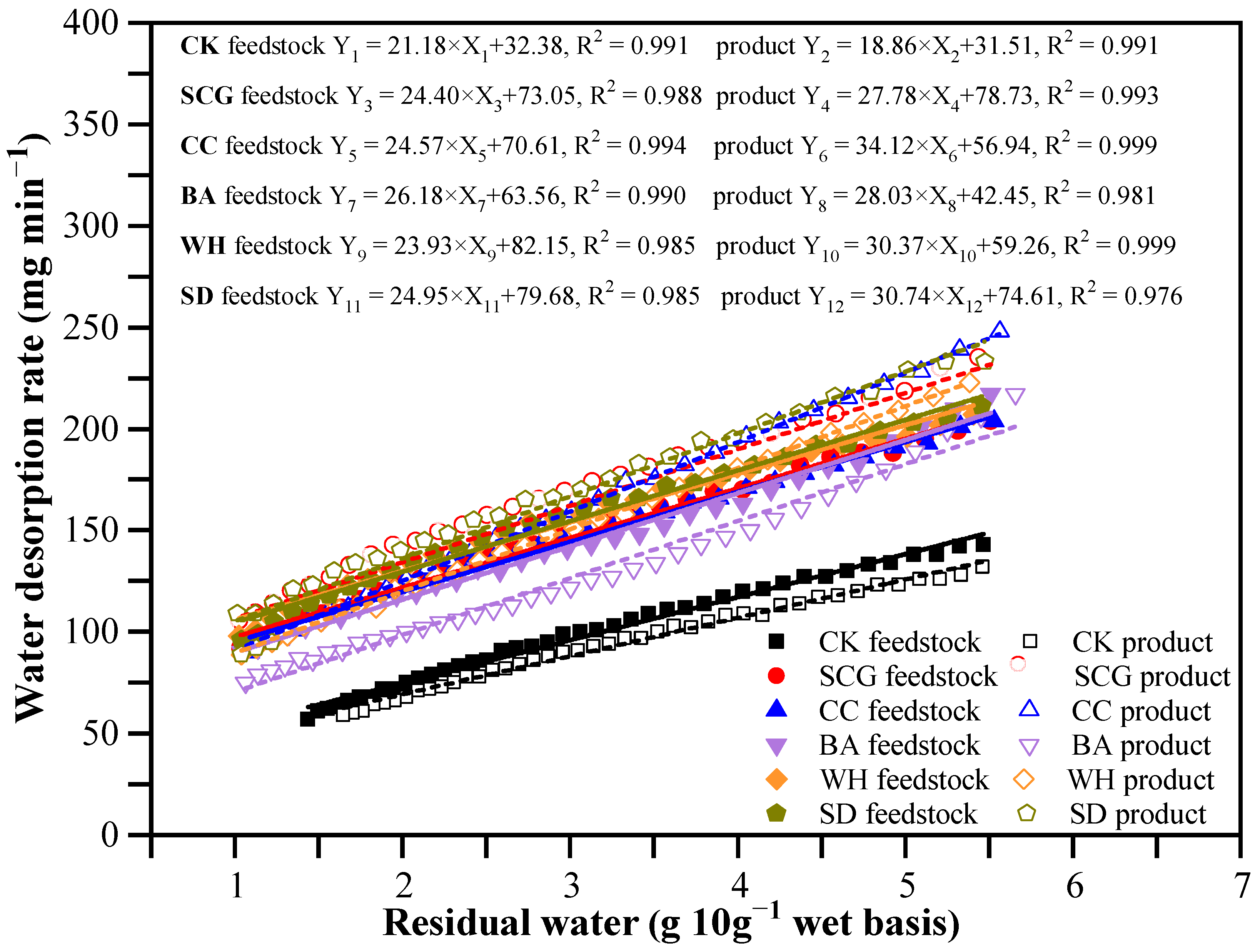
| DS | SCG | CC | BA | WH | SD | |
|---|---|---|---|---|---|---|
| MC (%) | 91.26 | 0 | 0 | 0 | 0 | 0 |
| VS (%, dry basis) | 78.04 | 97.54 | 96.12 | 94.70 | 89.80 | 95.17 |
| Organic components (mg·g−1 TS) | ||||||
| Hemicellulose | 104.51 | 122 | 190.56 | 159.17 | 127.85 | 141.49 |
| Cellulose | 18.01 | 121.23 | 300.54 | 467.16 | 324.34 | 352.65 |
| Lignin | 27.97 | 348.83 | 153.42 | 362.22 | 155.33 | 171.94 |
| Proteins | 290.65 | 138.00 | 95.06 | 26.32 | 143.02 | 125.93 |
| Lipids | 24.27 | 135.14 | 13.55 | 10.56 | 26.95 | 16.20 |
| Amylums | 115.09 | 153.57 | 140.08 | 151.56 | 177.66 | 165.33 |
| Dissolved organic matter (DOM) (mg·g−1 TS) | ||||||
| Proteins | 26.58 | 16.36 | 11.63 | 11.01 | 5.46 | 7.98 |
| Polysaccharides | 7.76 | 12.17 | 20.07 | 12.03 | 6.89 | 4.76 |
| Reducing sugars | 1.73 | 6.43 | 8.42 | 3.30 | 0.77 | 0.82 |
| Others | ||||||
| Electric conductivity (EC) | 89.3 | 84 | 170.0 | 84 | 130.4 | 135.9 |
| pH | 6.81 | 6.53 | 5.21 | 5.74 | 6.69 | 4.01 |
| Dissolved chemical oxygen demand (DCOD) (mg·g−1 TS) | 77.56 | 88.78 | 91.93 | 17.49 | 186.12 | 22.39 |
| NH3-N (mg·g−1 TS) | 3.57 | 3.34 | 3.70 | 0.39 | 19.34 | 12.09 |
| Elemental content (%, dry basis) | ||||||
| C | 34.77 | 50.00 | 41.60 | 44.10 | 39.00 | 42.53 |
| N | 5.47 | 2.49 | 0.94 | 0.40 | 1.63 | 5.97 |
| H | 5.12 | 6.27 | 5.41 | 5.15 | 5.42 | 5.30 |
| S | 0.82 | 0.16 | 0.07 | - | 0.16 | - |
| O | 31.90 | 38.60 | 48.10 | 45.00 | 43.60 | 41.37 |
| Parameters | Samples | CK | SCG | CC | BA | WH | SD |
|---|---|---|---|---|---|---|---|
| C (%, dry basis) | Biodrying feedstock | 34.77 | 46.83 | 40.17 | 42.17 | 38.16 | 40.91 |
| Biodried product | 25.96 | 46.44 | 40.04 | 42.36 | 34.09 | 40.09 | |
| N (%,dry basis) | Biodrying feedstock | 5.47 | 3.11 | 1.88 | 1.45 | 2.42 | 5.87 |
| Biodried product | 3.59 | 4.00 | 2.96 | 1.11 | 3.00 | 5.77 | |
| H (%, dry basis) | Biodrying feedstock | 5.12 | 6.03 | 5.35 | 5.14 | 5.35 | 5.27 |
| Biodried product | 4.47 | 5.81 | 5.29 | 5.25 | 4.77 | 5.31 | |
| S (%, dry basis) | Biodrying feedstock | 0.82 | 0.30 | 0.22 | 0.17 | 0.30 | 0.17 |
| Biodried product | 0.97 | 0.38 | 0.44 | 0.20 | 0.68 | 0.27 | |
| O (%, dry basis) | Biodrying feedstock | 31.90 | 37.23 | 44.74 | 42.31 | 41.12 | 39.40 |
| Biodried product | 26.72 | 33.99 | 37.75 | 39.94 | 36.38 | 38.46 | |
| HHV (kJ/kg) | Biodrying feedstock | 14,975.75 | 17,720.28 | 14,810.22 | 14,834.17 | 15,241.10 | 14,957.79 |
| Biodried product | 14,387.81 | 16,034.68 | 12,121.21 | 13,653.36 | 13,800.84 | 14,596.64 | |
| LHV (kJ/kg) | Biodrying feedstock | 1755.35 | 3750.09 | 2989.07 | 3043.47 | 3038.77 | 2885.73 |
| Biodried product | 2578.16 | 4984.30 | 3385.04 | 3203.75 | 3764.41 | 3555.63 |
Disclaimer/Publisher’s Note: The statements, opinions and data contained in all publications are solely those of the individual author(s) and contributor(s) and not of MDPI and/or the editor(s). MDPI and/or the editor(s) disclaim responsibility for any injury to people or property resulting from any ideas, methods, instructions or products referred to in the content. |
© 2023 by the authors. Licensee MDPI, Basel, Switzerland. This article is an open access article distributed under the terms and conditions of the Creative Commons Attribution (CC BY) license (https://creativecommons.org/licenses/by/4.0/).
Share and Cite
Hu, Z.; Hao, Z.; Lei, H.; Guo, Y.; Chen, Q.; Zhang, W.; Rao, P. Effect of Bulking Agents on Dewatered Sludge Biodrying Followed by Thermal Drying. Processes 2023, 11, 1392. https://doi.org/10.3390/pr11051392
Hu Z, Hao Z, Lei H, Guo Y, Chen Q, Zhang W, Rao P. Effect of Bulking Agents on Dewatered Sludge Biodrying Followed by Thermal Drying. Processes. 2023; 11(5):1392. https://doi.org/10.3390/pr11051392
Chicago/Turabian StyleHu, Zhengjie, Zongdi Hao, Huan Lei, Yibin Guo, Qi Chen, Wenqi Zhang, and Pinhua Rao. 2023. "Effect of Bulking Agents on Dewatered Sludge Biodrying Followed by Thermal Drying" Processes 11, no. 5: 1392. https://doi.org/10.3390/pr11051392





